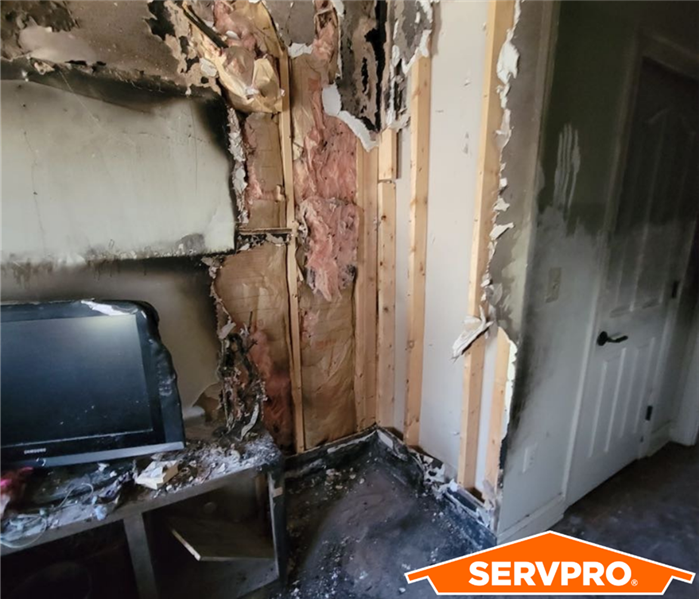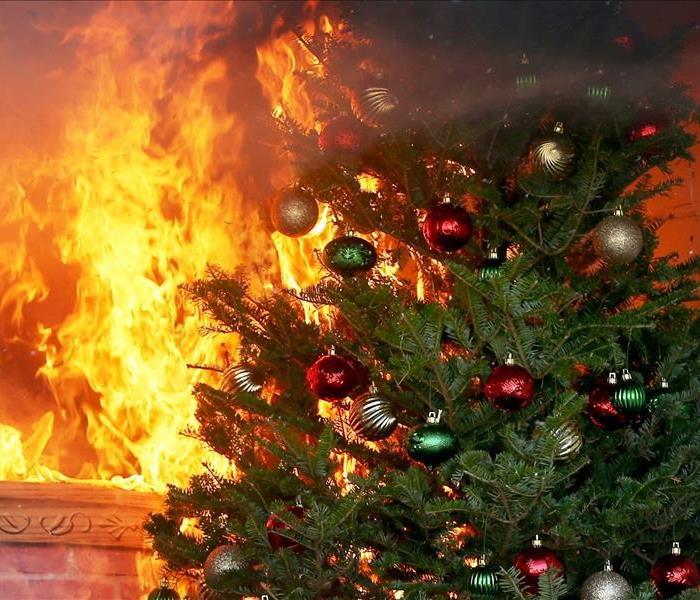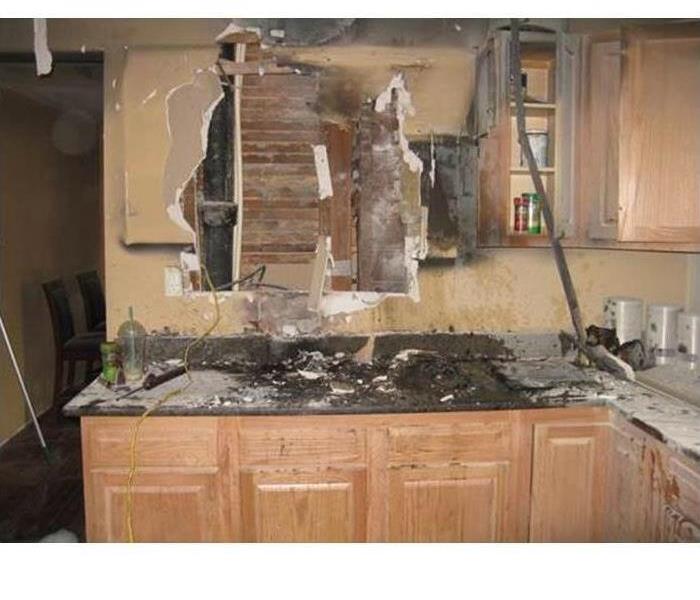Archived Fire Damage Blog Posts
Electrical Fires Are No Joke.
9/16/2022 (Permalink)
 Even the TV was melted in this electrical fire.
Even the TV was melted in this electrical fire.
We here at SERVPRO encounter many different fire damage emergencies, from gas stoves improperly turned off, to faulty heaters. Arguably, electrical fires can be the most sinister. They are mostly preventable if you take the proper precautions, like not overloading any one outlet or not running cords underneath carpets. Sometimes though, they just short out, like at this job we finished recently.
When the wall outlet on the second level bedroom of this townhouse blew, it started a fire that consumed the whole floor. The walls, ceiling, and floor of each room suffered massive damage and were beyond repair. Our mitigation team was forced to completely gut the entire area, stripping away everything to just floorboards and studs.
The only precaution that may have avoided this disaster is making sure that every ten years, a licensed electrician checks the home’s entire electrical system. Aside from that, you can always count on our mitigation team to clear out the damage, and our construction team to then rebuild it.
'Tis the Season - Fire Safety Tip #1
11/30/2020 (Permalink)
 Holiday Safety Tip #1
Holiday Safety Tip #1
'Tis the Season to be festive and merry with decorations around the house. You will most likely find amidst those decorations the glorious Christmas Tree in all its glory!
According to the NFPA, between 2013-2017, U.S. fire departments responded to an average 160 home fires that started with Christmas trees per year.
Here are a few tips to help prevent a tragedy in your home this year.
- Pick a fresh-looking tree
Fresh trees are much less likely to catch fire, according to the American Christmas Tree Association. If purchasing a real Christmas tree, it’s essential to choose a tree with green needles, regardless of the type of tree.
You can also tell a fresh tree from a dry one by handling the foliage. Signs of a fresh tree include soft and flexible needles that don’t easily fall off.
Fir needles from a fresh tree should crisply snap if you fold them. Experts recommend continuing to test your tree’s needles for freshness throughout its duration in your home.
- Keep the tree watered
Constant moisture is key, because a dried-out Christmas tree in a home is a recipe for disaster.
In fact, a parched tree can burn faster than newspaper, according to the NFPA.
Experts recommend keeping a real tree watered at all times to ensure that it remains consistently moist.
A medium to large Christmas tree can drink up to a gallon of water a day.
- Keep tree away from heat
Ensure that the tree is at least 3 feet way from any heat source, including fireplaces, radiators or heat vents, the NFPA recommends.
Experts also recommend that lit candles should NEVER be used to decorate a tree.
- Shake the tree
Give your real tree a good shake, experts suggested. If you find that a lot of needles fall to the ground, it’s a sign that the tree isn’t getting enough water, which poses a fire risk.
- Check the tree’s lights
Faulty lights can cause a tree to ignite, which is why It’s essential to check the lights you use to decorate the tree.
The NFPA recommends using lights that are listed by a qualified testing laboratory and keeping in mind that some lights are only for indoor or outdoor use.
Examine the lights and keep an eye out for any frayed wires, broken bulbs and any loose connections, he recommended. If you spot signs of damage or wear, the lights should be replaced.
Experts also recommend preventing a short circuit by avoiding overloading extension cords and power sockets with Christmas tree light strands.
- Turn off your tree’s lights
Ensure that your lights are always turned off when you’re not around to keep an eye on them, experts suggested.
- Get rid of your tree soon after the holidays
We at SERVPRO of Panhandle wish you a Safe and Happy Holiday!
Fire Safety Tips During Grilling Season
8/18/2020 (Permalink)
Ahhhh summer...a time when friends and family get together to enjoy the beautiful weather to eat and especially during the hot summer months…cook outdoors! And, who doesn’t love a good BBQ? 70% of US households own a grill and odds are will fire it up at least once a week during the summer. Be that as it may, it is also when fire can become an issue for your home and property. According to the U.S. Fire Administration, roughly 5,700 grill fires take place on residential property every year amounting to an annual average of $37 million in damages.
As you fire up your grill or smoker of choice, here are some basic tips:
- When grilling, it is important to do so in a safe environment. Have a space outdoors where you can set up a grill safely and on level ground with a three-foot space between any structures nearby that could catch fire.
- If you live in a condominium or an apartment, check with your landlord/property manager to find out if grilling on your balcony area is acceptable before you do it!
- When lighting/igniting your grill, always open the lid prior to turning on the propane. Backdrafts can occur if you leave the lid closed while lighting.
- Be sure to wear short sleeve clothing when grilling to stay safe from the grill flames.
- NEVER leave the grill unattended!
- Be sure you have a fire extinguisher nearby to put out any fires that may occur.
- Clean your grill after each use to prevent grease fires.
- Dispose of used coals in a metal can with lid after they have cooled.
We at SERVPRO of Panhandle hope you stay safe and enjoy cooking outdoors safely!
Fire Safety - Kitchen
10/29/2019 (Permalink)
 View the same kitchen after SERVPRO was there by copying this link to your browser. https://www.SERVPROpanhandle.com/before-after-photos/
View the same kitchen after SERVPRO was there by copying this link to your browser. https://www.SERVPROpanhandle.com/before-after-photos/
Fire damage restoration is our specialty. We are trusted experts in our field. We are here when you need us. Before that time comes we like to provide you with information to keep you and your loved ones away from harm. Some disasters can be prevented. SERVPRO of Panhandle cares about the community we serve.
Grease fires - we’ve heard of them, maybe even experienced them, but what about them?
Well, first of all, they can happen to anyone. The most common reason a grease fire occurs is leaving a pan on the stove unattended with oil in it. The oil heats up, smokes and eventually catches fire. You don’t have to spill grease or have something else flammable nearby. Oil in a pan unattended, heating up past the smoking point, will get to the point it sets itself on fire.
Guess what, it’s happened to me and this may be a shocker to you but it was SILENT! No smoke alarm, nothing. Just flames shooting up out of my pan. I was fortunate because although I did also have something very flammable next to it (another no no) it didn’t ignite.
Enough about me. If this happens to you, you need to smother the fire and take the oxygen away. A metal cover or cookie sheet are good options for smothering the fire (glass will shatter from heat). You can also use salt or baking soda but only for a very small fire otherwise you will need large amounts to dump on and smother the fire. Flour and other items that seem like salt or baking soda are NOT the same and should not be used. It is also wise to have a special extinguisher in the kitchen for this type of fire. Be sure you know what you are using before spraying it, all extinguishers are not created equal. The best thing to do is pay attention and don’t leave the stove unattended and, of course, call the fire department if things are out of hand.
Ok, I’ve held out long enough. I can’t talk grease without thinking of bacon. If you are someone that likes bacon or cooks bacon for others that like bacon…I have a method for cooking bacon your bacon eaters will love!
At first I resisted this method because I thought it would soak up too much grease, yada, yada, yada. I’m here to tell you this method of frying bacon beats ALL other methods. I’ve never seen this method anywhere else (except my mother-in-laws kitchen). There’s no splatter, the bacon cooks evenly and it doesn’t curl up needing to be pressed to the pan. Perfect every time and easy. (I’ve never set this on fire.)
Here’s what you do.
- Open bacon package of your choosing just needs to be sliced first.
- Cover another plate with flour (amount depends on how much bacon you cook).
- I take scissors and cut the bacon in half so the strips are shorter (I like this a lot!!!).
- Dredge each piece in the flour (both sides of bacon should be covered with flour).
- Place bacon on frying pan (I prefer flat electric skillet, so grease can drain off).
- At about 325° the bacon will cook nice and even, flip after a few minutes when the bottom is browned.
- Remove from pan and place on a plate lined with paper towels to drain any excess grease.
- Store in fridge or enjoy immediately. You can even freeze it for quick use in the future. I just warm it up in the microwave when I need it.
There you go! Next time you cook something, remember to be attentive and not let the oil get too hot and if you use this recipe remember it was SERVPRO of Panhandle that saved your bacon!
https://youtu.be/WcffMgKUmMc
Fire Safety - Campfires
8/8/2019 (Permalink)
Here at SERVPRO of Panhandle we pride ourselves on being a leader in fire and water damage restoration. Our highly trained specialists are trustworthy and “faster to any size disaster.” We have a “restore first” mentality that helps keep the costs down and get you back into your home or business faster.
When the panic of a disaster hits you will be glad you thought ahead...put SERVPRO of Panhandle in your phone NOW. If disaster strikes we are here for you 24/7/365! Call SERVPRO of Panhandle (304) 263-0640
Having said that...let’s discuss outdoor fire safety.
It’s the end of Summer. School is starting. The temps are high and the ground and brush are most likely dry. You have a lot on your mind while trying to soak up the last days of summer camping and outdoor fun.
My name is Anne Marie and today I’d like to share the rules of building a campfire.
First things first, make sure ahead of time that you are allowed to have a campfire where you are located. (That would certainly put a damper on things.)
Next, check that there are no burn bans in place. If there aren’t then observe the area for windy conditions. Very important so things don’t get out of hand.
You are now ready to dig your pit. Select a spot without any overhanging branches.
Now that you have your pit, circle it with rocks and rake a 10 foot area around the pit. Once completed there should be just dirt in this area, nothing that could catch fire should be left on this ground.
If you have extra firewood/kindling stack it upwind and away from the fire. Don’t leave anything around that could be a tripping hazard.
Never leave a campfire unattended by an adult.
Keep a hose or a bucket of water close by at all times. You should always have a metal shovel as well.
When you are ready to call it a night or leave the fire be sure it is extinguished. This means douse it with water, stir it up with a shovel and dump more water on it. The fire should be cold beyond a shadow of a doubt before you leave.
Please also remember: Only burn wood.
The above rules are not just for camping they are for the fire pit in your backyard as well. When things are easy and convenient we sometimes become more lax with adhering to these rules.
This is a personal experience of mine. I was visiting a friend that had a fire pit in their yard. It was around 10 AM when I knelt down to pick something up in the area of their fire pit. The ground was quite warm. I alerted my friend to the situation. They had used the fire pit the night before. Upon stirring the ashes we saw that down below there were still red coals. There was a plant/weed that had very long roots that connected from plant to plant that grew in the area. These roots had “caught fire” so to speak, there wasn’t enough oxygen for them to ignite but they were red at the pit and carried the heat just below the surface of the ground. If this had reached the woods or an uncleared area this story could’ve ended very differently. What did they do wrong? The fire had been left cold enough instead of completely cold. So, while no one in my story needed to call SERVPRO, make sure you are prepared in case someone in your story does.
Add SERVPRO of Panhandle (304) 263-0640 to your contacts today!




 24/7 Emergency Service
24/7 Emergency Service


